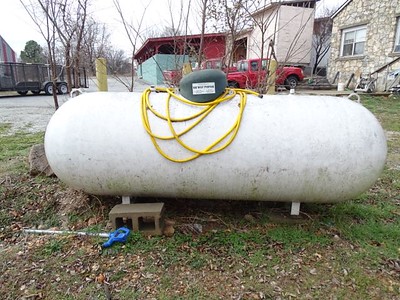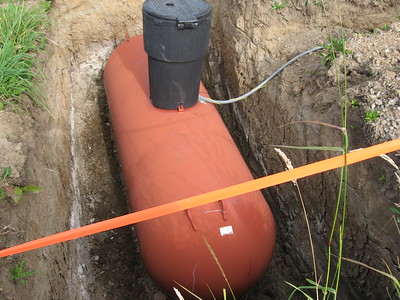
Standard 250-gallon propane tanks are 92 inches long (7 feet and 8 inches) and 30 inches in diameter. In order to install a 250-gallon tank, you will need to reserve roughly the following space: A good length is 8 feet. You need a few inches more for piping, so the recommended height is not 7’8″, but 8′. A width of 2.5 feet. A height of 2.5 feet. It can be installed above ground (above ground) or below ground (below ground).
You might find the weight of the 250-gallon tank useful as well. These tanks are quite heavy, and you will need to be able to handle them. A 250-gallon propane tank weighs 483 lbs when empty and 1,333 lbs when full. One gallon of propane weighs 4.11 lbs. It is best to install it empty (that’s almost 500 pounds of weight), then fill it up.
How much does an empty 250 lb propane tank weigh?
An empty 250 lb propane tank typically weighs around 70-80 lbs. This is an approximate weight, as the exact weight can vary based on the materials used to construct the tank and the specific manufacturer. Propane tanks are often made from materials such as steel or aluminum, both of which have different densities and therefore contribute to the overall weight of the tank. In addition, the size and shape of the tank can also affect its weight.
How large is a 250-gallon propane tank?
A 250-gallon propane tank typically has dimensions of around 48 inches in diameter and 63 inches in height. These dimensions can vary slightly depending on the manufacturer and the specific model of the tank. The size of a 250-gallon propane tank is large enough to provide heating and hot water for a moderate-sized home, or to fuel a variety of commercial and agricultural applications.
It’s important to make sure that you have enough space for the tank to be installed safely and legally. In many cases, you’ll also need to obtain a permit from your local government to install a propane tank in your backyard, so be sure to check the relevant regulations in your area.
If you’re considering installing a 250-gallon propane tank in your backyard, it may be a good idea to have a professional assess the space and provide guidance on the best placement and installation options.
How much propane is in a 250-gallon tank?
Most 250-gallon tanks hold around 200 gallons of propane. This is because the tank is only 80% full to allow for the expansion of the liquid propane. One gallon of propane gas contains approximately 91,600 BTUs of energy, so a 250-gallon tank would hold approximately 96,000-100,000 BTUs of propane. This is a significant amount of energy, and it can be used for a variety of applications depending on the needs of the user.
How long will a 250-gallon propane tank last?
Homeowners can use propane tanks to heat their homes during the winter, and they are an excellent energy source for many home appliances. It is common for homeowners to wonder how long propane tanks such as 250 gallons will last when used regularly. With a little bit of knowledge about propane and its usage, homeowners can maximize the efficiency of their tanks. The purpose of this article is to examine how long 250-gallon propane tanks last in residential properties and what factors affect their longevity.
A 250-gallon propane tank can last anywhere from 7 days to 4 weeks, depending on a number of factors. The first factor is the climate. In a warmer climate, you will use more propane for cooking and heating than in a cooler climate. The second factor is the size of your home. A smaller home will use less propane than a larger home. The third factor is the number of people in your household.
A larger household will use more propane than a smaller household. Finally, the fourth factor is how often you use propane-powered appliances. If you use them frequently, you will use more propane than if you use them infrequently.
How thick is the metal on a 250-gallon propane tank?
The thickness of the metal on a 250-gallon propane tank can vary depending on the specific tank and manufacturer. Propane tanks are typically made from steel or aluminum, and the thickness of the metal used can vary based on the intended use of the tank and the regulations that it must meet.
In general, propane tanks for residential use tend to have thinner metal than tanks for commercial or industrial use. This is because residential tanks are designed to hold smaller amounts of propane and are typically used for relatively low-demand applications, such as heating and cooking. Commercial and industrial tanks, on the other hand, are designed to hold larger amounts of propane and are used for more demanding applications, such as operating forklifts or generating electricity. As a result, these tanks may have thicker metal to withstand the higher pressure and demand for propane.
It is important for propane tanks to have a sufficient metal thickness to ensure their safety and durability. Thinner metal may be more prone to damage or leakage, while thicker metal can better withstand the pressures of storing and using propane.
How much does it cost to fill a 250 lb propane tank?
The cost to fill a 250 lb propane tank can vary depending on several factors, including the current cost of propane, the location of the tank, and the provider that is filling the tank. On average, it can cost anywhere from $30 to $100 or more to fill a 250 lb propane tank.
The cost of propane can vary significantly depending on the location and the time of year. Propane is typically more expensive in the winter months when demand is higher, and it can also be more expensive in certain regions of the country due to differences in supply and demand. In addition, the cost of propane can fluctuate based on the price of crude oil, as propane is often produced as a byproduct of oil refining.
The location of the propane tank can also affect the cost of filling it. Propane suppliers often charge more for delivery to remote or rural areas, or for tanks that are located on upper floors or in difficult-to-access locations.
Finally, the provider that is filling the tank can also have an impact on the cost. Different propane suppliers may have different pricing structures, and some may offer discounts or promotions to attract new customers.
In conclusion, the cost to fill a 250 lb propane tank can vary widely depending on the current cost of propane, the location of the tank, and the provider that is filling it. On average, it can cost anywhere from $30 to $100 or more to fill a 250 lb propane tank.
How far does a 250-gallon propane tank need to be from the house?
The distance that a 250-gallon propane tank must be located from a house or other structure is typically regulated by local building codes and propane industry guidelines. These regulations are in place to ensure the safety of the occupants of the structure, as well as the safety of the propane tank itself.
According to the National Fire Protection Association (NFPA), the minimum distance that a propane tank must be located from a house or other structure depends on the size of the tank. For a 250-gallon propane tank, the minimum distance is typically 10 feet. This distance is intended to provide a safe buffer between the tank and the structure in case of a leak or other issues with the tank.
In addition to the minimum distance requirement, there are also guidelines for the placement of a propane tank relative to other structures and hazards. For example, a propane tank must typically be located at least 5 feet from any opening in a structure (such as a window or door), and at least 25 feet from any ignition source (such as a furnace or water heater).
It is important to note that these guidelines are just that – guidelines. Local building codes and regulations may have more stringent requirements for the distance that a propane tank must be located from a structure. It is always a good idea to check with your local building department or a qualified propane professional to determine the specific requirements for your location.
Proper installation of a propane tank is critical to ensure the safety of the occupants of the structure and the tank itself. It is important to follow all applicable guidelines and regulations when installing a propane tank and to have the tank inspected and maintained regularly to ensure that it is in good working order.

Mike is an experienced propane technician with over 15 years of professional experience in the field. He has dedicated his career to helping customers with their propane needs, from installation to maintenance and repair. Together with Jeremy, he co-founded this website to provide useful information and guidance to customers seeking reliable propane services.




